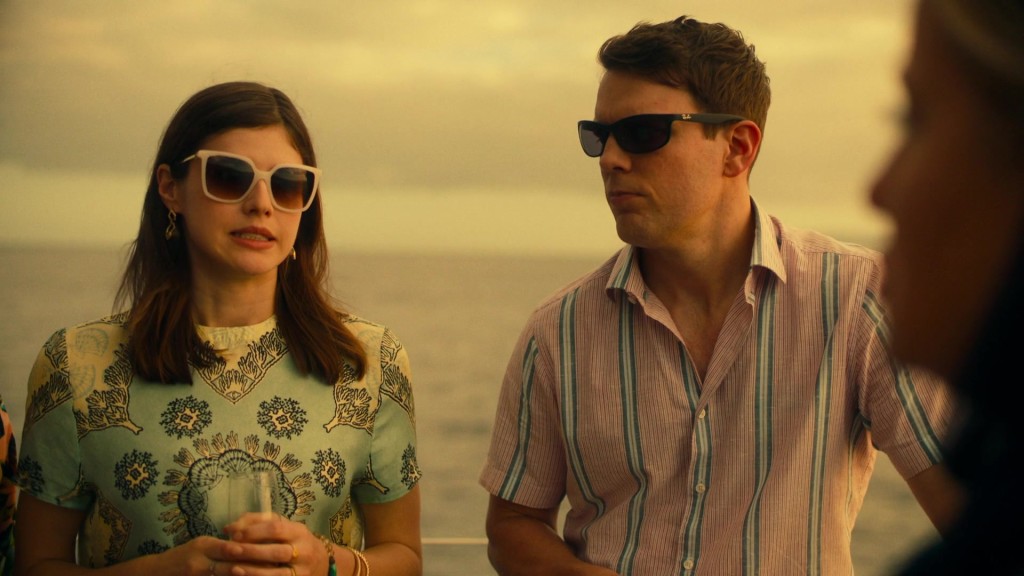I originally had no desire to watch this show. It was actually one of you guys who made me check it out. I don’t remember who said it but the comment was essentially: “This is the first show that I’ve loved where I disliked every single character.”
I thought to myself, “Hmmm, that’s interesting.” For those who don’t follow screenwriting, here’s a little inside baseball for you. There’s an unofficial ongoing competition between all screenwriters to create the most popular piece of media but only using unlikable characters. Anybody can create something popular with likable characters. But it’s only the *truly talented* writers who can create something popular with unlikable characters. It seems like creator Mike White may have just won that competition.
To give you a little background, this is not a show that White spent years trying to make. Quite the opposite, actually. With the arrival of Covid, HBO found themselves in a pinch. They needed contained show ideas that had little risk of spreading Covid. So they ran around to a bunch of creators and asked them if they had something that could be shot on a single set.
With that being the only edict, White came up with this idea: group of rich people spending a week at a luxurious Hawaiian resort. He wanted to explore the constant interaction, on these islands, between rich and poor people. But HBO threw White a curveball. They needed to start shooting in three months. So Mike White proceeded to write six episodes, which were 60 pages each mind you, in just three months, while simultaneously preparing to direct the series.
Which may be the most shocking detail about White Lotus of all. Because this is some of the best character work I’ve enter encountered. I’m talking EVER. And, usually, it’s the character creation that takes the longest to get right. It’s hard enough to come up with one memorable character. White Lotus somehow comes up with ten. Even if you don’t like this show, it’s impossible to forget these characters. You will be thinking of them years from now.
Which is why I wanted to do an entire week of analysis on the show’s character development, starting with the pilot episode. To be clear, in 95% of the amateur scripts I read, I don’t remember a single character in the scripts 72 hours later. With this show, it’s the opposite. These people are ingrained in my mind for the rest of my life. That’s how strong the character creation was. And I’m curious to delve into the material to find all the little tricks of the trade Mike White used to achieve this.
For those who haven’t seen the show, the premise is simple. A group of very rich people come to a Hawaiian island resort to spend a week of high-end relaxation. They include Shane Patton, an exorbitantly rich 30-something mama’s boy who lives off his parents’ money. He’s come here with his new wife, Rachel, a drop dead gorgeous writer who was dirt poor when she married Shane.
You then have the Mossbachers. You have Nicole, a genuine woman who has become one of the most successful female CEOs in the US. You have her husband, Mark, who came from a rich family but lives in the shadow of his richer more famous wife.
You have their 19 year old daughter, Olivia, who uses her family’s wealth when it’s convenient, such as to be a “queen bee” at school. But then tells everyone around her that she identifies as a socialist in order to play the victim role. Olivia’s ultimate socialist act is befriending a poor Latina girl named Paula, who she’s brought with her on the trip. But don’t feel bad for Paula. Paula uses her friendship with Olivia as a way to climb the social ladder and wield the same power Olivia uses to control those around her.
The runt of the family is 16 year old Quinn, an anxious kid who’s so socially awkward that he buries himself in his phone and tablet. He’s got classic “weird kid” syndrome, where, although the parents would never say so out loud, they’re terrified he won’t be able to make it in the real world.
From there, you’ve got two wild-card characters. There’s 60 year old Tayna McQuoid, a socialite who’s draped in money although where she got it is anyone’s guess. This eccentric oddball has come here on a spiritual journey to spread her mother’s ashes in the ocean.
And then you have one of my favorite characters ever. Yes, I just said *EV-ER*. As in, this character deserves to be placed in the pantheon of greatest TV characters of all time – Armond, the hotel manager. Armond starts off as the only person in this story who seems to have their shit together. But as we’ll eventually find out, there’s nothing further from the truth.
Before we start, it’s important to note that this is a TV show but White treats it like a long movie. The characters *will* arc. That wouldn’t happen if this was a multiple season TV show. In multiple-season shows, you keep your characters struggling with their fatal flaws throughout the series. It would be weird if you wrapped their internal struggles up after one season. I bring this up because the approach to character development in this show should be seen through a “feature film” lens as opposed a “TV show” lens, if that makes sense.
In today’s article, I’m going to show you how Mike White lays the foundation for the character development that occurs throughout the rest of the show. Remember that any effective character development depends heavily on the introduction of those characters. If you don’t effectively set up who these characters are, we won’t care where they go. Which is why character introductions are so important. Okay, let’s take a look.
The writers who go on to become professionals in this business understand that character introductions are one of the most crucial components of a screenplay and, therefore, require a disproportionate level of focus. Character introductions achieve two things. One, they tell us who the character is. And two, they explain to us what the character is going to be fighting, and hopefully overcoming, over the course of the story.
Now, what’s important to note in any ensemble story is that you may not be able to perfectly set up your characters the first time we meet them. Due to the fact that some environments allow for better introductions for some characters and weaker intros for others, it’s okay to DELAY some of the scenes where you truly tell us who a character is.
For example, the first official “this is who these characters are” introduction in White Lotus occurs on the boat heading to the island. All of our main characters are on this boat. But we focus specifically on friends Olivia and Paula. They’re perched in the upper deck, bitchily making assumptions about everyone on the boat. There is no doubt, after this scene, that these two are bitches.
Again, we could’ve then cut to the other characters on the boat and tried to establish them within this environment as well. But Mike White felt it wasn’t the ideal setting to do so. So he delayed their “this is who these characters are” moments. It isn’t until newly married couple Shane and Rachel are in their suite that we appropriately establish them.
Instead of jumping into exciting honeymoon sex, Shane looks around and realizes, wait a minute, this is the wrong room. His mother bought them the best room in the hotel. But they’re in some… lesser room. In Shane’s high-end world, this is unacceptable. He begins looking around and confirming his suspicions despite the fact that the room is still huge and gorgeous. This moment gives us a crystal clear understanding of who Shane is, especially after Rachel reminds him that it wasn’t *him* who paid for the room. It was his mother.
We’re about to get nerdy so pay attention, because the way White sets up Rachel is sneaky and something not a lot of writers consciously know how to do. You see, it’s easier to set characters up who are ACTIVE – who are creating the circumstances that are affecting the situation. That’s what Shane is doing. He’s charging round, creating this ‘problem’ of not being in the right room.
Meanwhile, Rachel isn’t active, yet we still get a good feel for her. This is how we do it: You can establish who someone is through their REACTIONS to what’s happening around them. In this case, Shane is bitching about the room. Yet here Rachel is, standing in the nicest hotel room she’s ever been in in her life. So that’s the argument she’s making. “Who cares? We’re on our honeymoon. This place is amazing. Let’s just enjoy ourselves.” In her reaction to Shane’s freak-out, we get just as good of a feel for her as we do Shane’s character, even though Rachel is reactive instead of active. We understand that she comes from a poor family. We also understand that she doesn’t need everything to be perfect to be happy. She’s much more down-to-earth.
We do the same thing for the rest of the hotel guests. Socialite Tanya has an awkward exchange with one of the helpers in her room as she can’t find her bags even though they’re right behind her. This woman is so out of touch with reality that she doesn’t even know where her 14 bags are despite the fact that they were literally placed behind her 30 seconds ago.
We then switch to Mark and Nicole’s room with a close-up shot of Nicole inspecting Mark’s penis. I’m not sure I love the idea of introducing someone via their penis. But the flip side of that is that so many character introductions are forgettable. And this one definitely isn’t. Also, to Mike White’s credit, it’s organic to the situation. Mark just had tests for testicular cancer and he’s waiting on the results. So we clearly understand where this guy’s head is at after this scene.
Of all the characters in White Lotus, Nicole probably has the weakest introduction. White tries to do the same thing he did with Shane and Rachel where we introduce Nicole via her reaction to her husband’s cancer situation. But it’s not as clear who she is after this moment as it was with Rachel. There is a good line in the exchange, though, that provides some insight into their marriage. He asks her if his testicles look different. Her response is, “I don’t know. I haven’t seen them for a while.” That tells us that these two don’t get intimate often, which indicates their marriage isn’t perfect. It’s little touches like this that you need to add if you want to get to that next level of character development.
Finally, we get Armond’s big introductory scene, and this one is a little more complex, so you have to pay attention to understand its genius. Basically, Shane comes to the front desk to complain about being in the wrong room. Armond is overtly polite with him. He says he’s sorry but that’s the room they booked. Then, as soon as Shane and Rachel leave, Armond turns to the new helper, Leilani, dropping the friendly act to inform her how these people are all evil and you have to tell them whatever they want to hear to keep them happy.
In other words, the beauty of this character is the distance between how he must outwardly act and what he actually feels, which is contempt and hatred for everyone. If Armond was a genuinely happy person and enjoyed helping people, he wouldn’t be interesting at all. It’s the contrast between how he must act and what he feels that creates this powder keg of a character who we’ll see deteriorate over the course of the show.
There’s another little character trick going on here with Armond that you can use yourself. Whenever you have a mentor-student relationship, it’s easier to get inside the mentor’s head because he’s constantly explaining what’s in his head and what he’s feeling to the student. Normally, it’s hard to convey thoughts to the reader/viewer. But you can tell us EXACTLY what someone’s thinking if you’ve written in this dynamic.
“See, in that instance, you just have to stay calm and tell them that they’re right. These people are leeches. They’ll take whatever they can. You put on a smile, tell them they’re right, but then stand firm as you explain that you’ve done everything you can do.”
Another great character-writing tip you can take from White Lotus is that Mike White is so focused on creating great characters that he even gives his secondary characters storylines. Leilani is an overweight helper here on her first day of work who has a secret. She’s nine months pregnant. But she’s terrified to tell anyone because she’s afraid she’ll lose her job. Over the course of the day, her water breaks, and she tries to hide it from everyone.
You’ll note that when Armand stops her, later, to ask her a series of questions, it’s a much more intense interaction than you would normally get between two people because WE KNOW Leilani’s secret, that she’s about to burst. We can see the pain in her eyes, along with her desperate attempts to appear normal. This is the kind of detail that professional writers bring to the table that I rarely see in amateur work. So it’s a good habit to develop, especially in television writing where there are a lot of characters.
So there you have it. Lots of great character work to learn from. Tomorrow we’ll get into, once you’ve established your characters, what to do with them. Seeya then!






